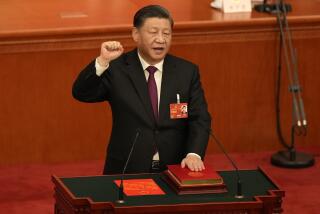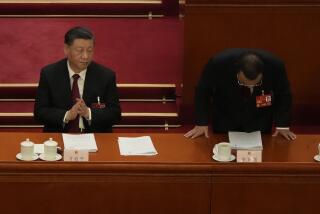China’s Top Leadership
- Share via
\o7 BEIJING\f7 — Following are brief sketches of China’s top leaders involved in the current pro-democracy crisis:
Deng Xiaoping, 84, is the most powerful leader in China even though the highest ranking position he holds is chairman of the Central Military Commission of the Communist Party.
Deng was purged twice during the 1966-76 Cultural Revolution and then staged a comeback that turned China around.
He transformed a country dominated by ideological battles into one with pragmatic, market-oriented economic policies.
Zhao Ziyang, 69, general secretary of the Chinese Communist Party since 1987, has been the leading advocate of rapid economic reforms.
As governor of Sichuan province in the late 1970s he led the country in successful experiments in restoring family farming.
In 1980 Deng brought him to Beijing and he was quickly named premier. He held that post until 1987 when he became party chief following the ouster of fellow reformist Hu Yaobang.
Li Peng, 60, premier since April, 1988. An electrical engineer, he studied in the Soviet Union in the 1950s and represents the technocrats now filling many government offices.
He has opposed Zhao’s moves in market-oriented reforms, saying he supports the plan but prefers a more cautious pace. Last September, after the inflation rate exceeded 30%, Li called for a two-year economic slowdown.
Yang Shangkun, 81, became China’s president, or head of state, in April, 1988.
Yang, a career military man, was active in Red Army campaigns in the 1930s and 1940s and was appointed permanent vice chairman of the Central Military Commission in 1982. He backed Deng’s 1985 decision to end the wartime footing of the army and reduce the force of more than 4 million soldiers by 1 million.
The post of president is largely ceremonial but Yang does exert influence because of his close ties to Deng.
More to Read
Sign up for Essential California
The most important California stories and recommendations in your inbox every morning.
You may occasionally receive promotional content from the Los Angeles Times.













